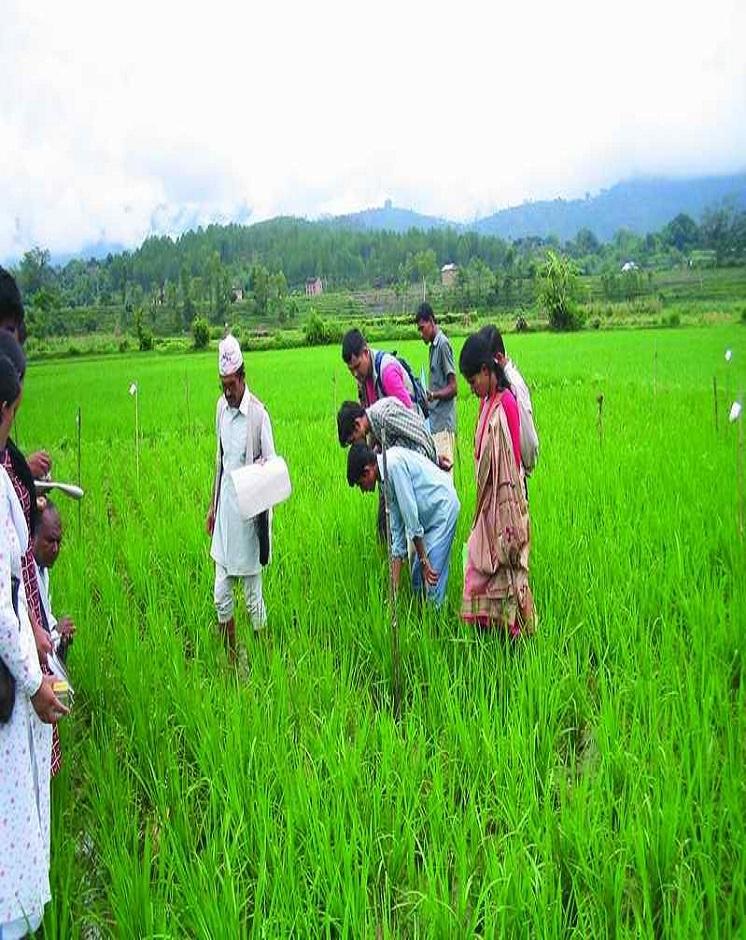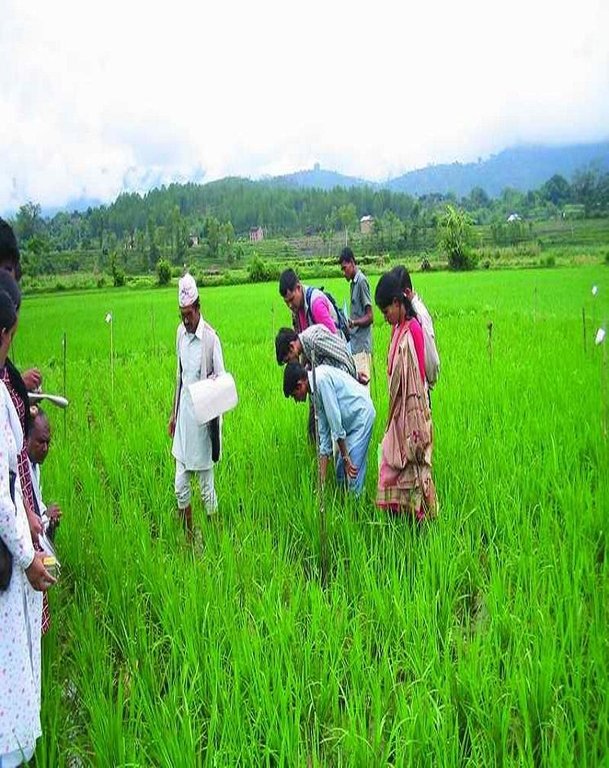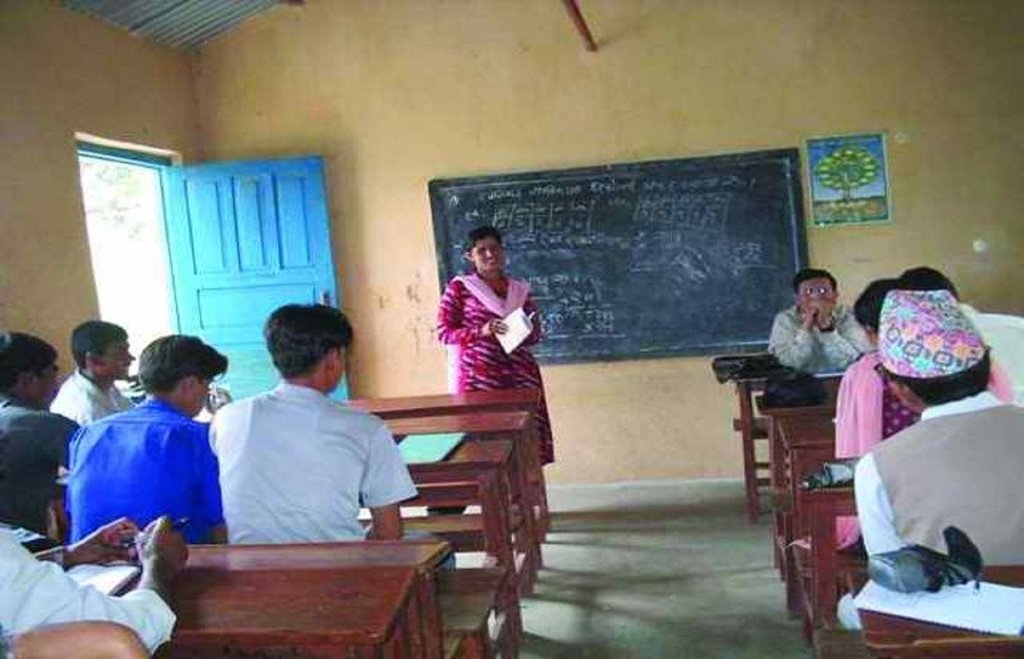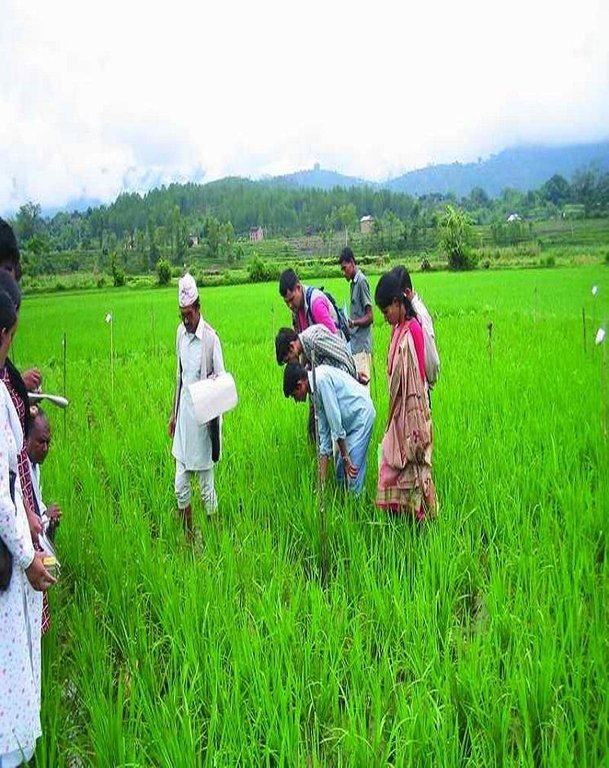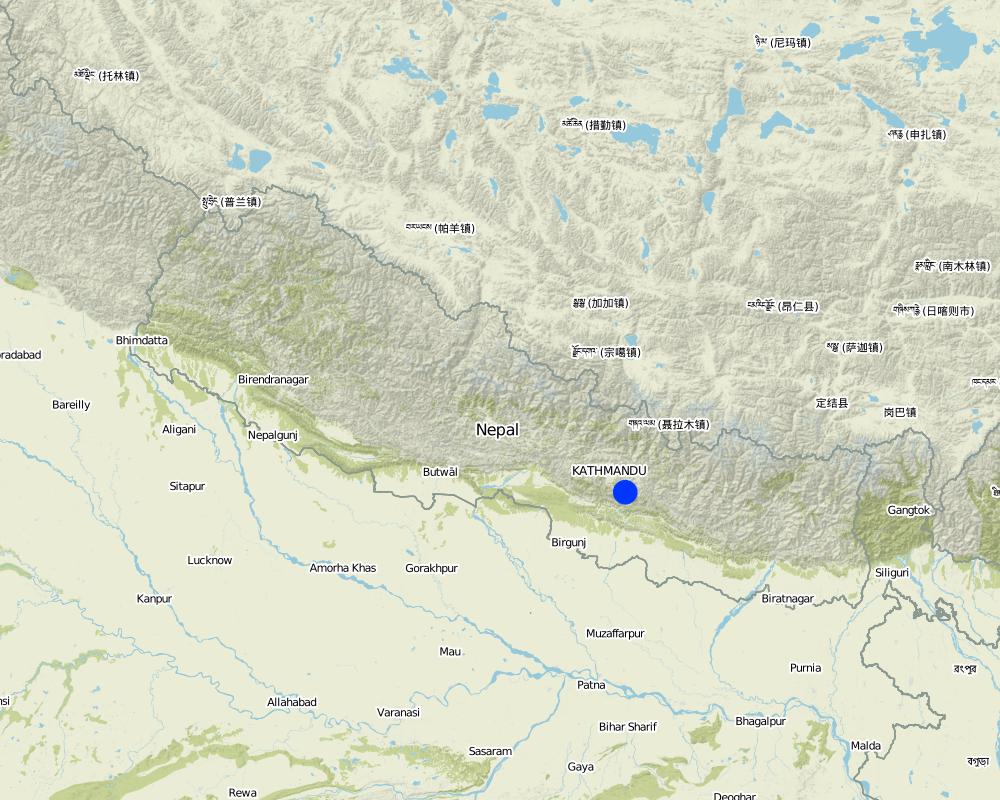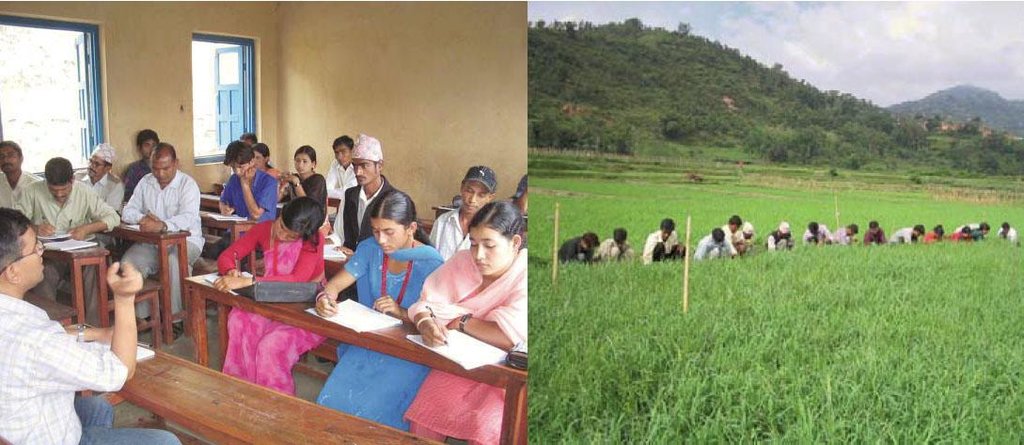Evaluation of the System of Rice Intensification through participatory research and development [尼泊尔]
- 创建:
- 更新:
- 编制者: Madhav Dhakal
- 编辑者: –
- 审查者: Fabian Ottiger
Sahabhagitamulak anusandhan ra bikas dwara dhan uttpadan bridhhi garne tarika ko mulyankan (Nepali)
approaches_2550 - 尼泊尔
查看章节
全部展开 全部收起1. 一般信息
1.2 参与方法评估和文件编制的资源人员和机构的联系方式
SLM专业人员:
有助于对方法进行记录/评估的机构名称(如相关)
CDE Centre for Development and Environment (CDE Centre for Development and Environment) - 瑞士有助于对方法进行记录/评估的机构名称(如相关)
ICIMOD International Centre for Integrated Mountain Development (ICIMOD) - 尼泊尔1.3 关于使用通过WOCAT记录的数据的条件
编制者和关键资源人员接受有关使用通过WOCAT记录数据的条件。:
是
1.4 SLM技术问卷的参考
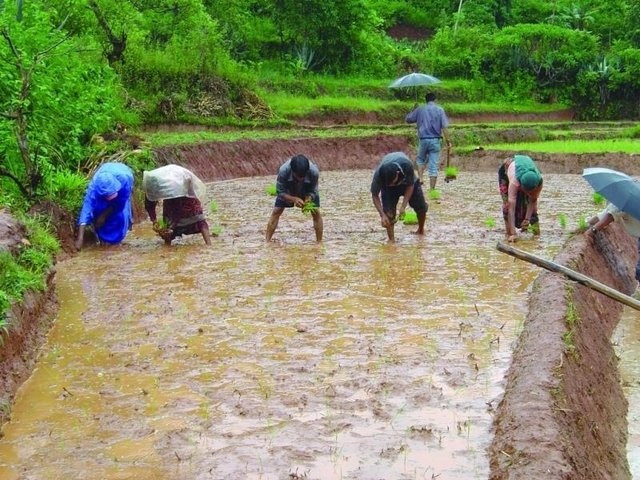
System of Rice Intensification [尼泊尔]
A method for increasing the productivity of rice by changing the management of plants, soil, water, and nutrients.
- 编制者: Madhav Dhakal
2. SLM方法的描述
2.1 该方法的简要说明
Conducting participatory action research with farmers and district level line agencies for demonstrating, disseminating and scaling up SRI
2.2 该方法的详细说明
该方法的详细说明:
Aims / objectives: PARDYP pilot tested SRI in the Spice Crop Development Centre (SCDC) at Tamaghat, Kavrepalanchok in 2002. The positive results led the technique to be tried out in 25 farmer’s fields in 2004 to evaluate whether SRI was technically feasible in the Himalayan middle mountains. Based on farmers’ interests and to promote SRI systematically, PARDYP organised interaction programmes between farmers who had and had not used SRI, village level group discussions, farmer-to-farmer visits and farmer-led on-site monitoring and evaluation in 2002, 2003 and 2004.
Methods: In 2005, the emphasis shifted to carrying out research with groups of farmers in a more systematic way and participatory rural appraisal methods and tools were used. The approach was called the SRI farmer field school (FFS) approach. Lead farmers (13 male and 6 female) were trained as SRI trainers and then facilitated village level farmer field schools for testing and promoting SRI. In 2005, SRI farmer field schools were run in 15 villages for about 100 farmers. Each school carried out hands-on training sessions to help farmers understand (1) the basic concepts of SRI and its practices, (2) methods for comparing traditional practices with SRI, and (3) how to observe, analyse and present findings more systematically. Monitoring and evaluation gathered both men’s and women’s perceptions. This also helped establish an informal farmer-learning network in the watershed. Village level discussions, farmer visits, and interaction with staff from the district agriculture offices continued. At the end of the on-farm experiments, a district level farmer’s day was organised to share the experiences gained.
Other important information: To promote wider understanding of the action research and encourage farmers to continue developing and adapting SRI, the project disseminated information about SRI through information, education and communication (IEC) materials aimed at community-level users, and a multi-media package on a CD ROM for the global audience and Nepali policy-makers and administrators. A national exchange workshop was held to share experiences from across the country on the use of SRI.
2.3 该方法的照片
2.5 采用该方法的国家/地区/地点
国家:
尼泊尔
有关地点的进一步说明:
Kavrepalanchowk/ Jhikhu Khola watershed
Map
×2.6 该方法的开始和终止日期
终止年份(若不再采用该方法):
2005
2.7 方法的类型
- 基于项目/方案
2.8 该方法的主要目的/目标
The Approach focused mainly on SLM with other activities (Rice cultivation, watersaving, agronomic innovation)
- To demonstrate and evaluate the innovative SRI technique under local conditions with land users' participation. - To inform farmers about the basic concepts, associated principles, and technical know-how related to SRI. - To share knowledge gained on SRI with a wider audience. - To scale up the innovation across larger areas
The SLM Approach addressed the following problems: - Lack of systematic on-farm research for developing a technology that takes into account farmers' needs. - Weak institutional collaboration for technology development, dissemination and scaling up. - Poor soil fertility, limited crop production, and poor irrigation facilities
2.9 推动或妨碍实施本办法所适用的技术的条件
财务资源和服务的可用性/可得性
- 阻碍
Government incentives lacking
Treatment through the SLM Approach: The innovation is cost effective and doesn't need additional inputs
机构设置
- 阻碍
Lack of cordination among land users
Treatment through the SLM Approach: Informal SRI farmers network established with trained human resources.
法律框架(土地使用权、土地和水使用权)
- 启动
The existing land ownership, land use rights / water rights greatly helped the approach implementation: The individual land use rights helped in implementing the technology as there were no conflicts among land users.
了解SLM,获得技术支持
- 阻碍
It is not a priority area of line agencies
Treatment through the SLM Approach: Sharing of technical know how with concerned stakeholders
其他
- 阻碍
lack of awareness
Treatment through the SLM Approach: Trainings, group discussions , field visits
3. 相关利益相关者的参与和角色
3.1 该方法涉及的利益相关者及其职责
- 当地土地使用者/当地社区
Spices Crop Development Centre and farmer groups
Women are generally busy with in-house work. There was only 30 % women participation. Initially SRI was demonstrated onindividual farmers' field. Working land users were mainly men (about 30 percent were women), villlage level groups were formed.
- NGO
PARDYP project
- 国家政府(规划者、决策者)
- 国际组织
如果涉及多个利益相关者,请注明领导机构:
Concept and orientation - national specialists and implementation of the approach jointly with land users.
3.2 当地土地使用者/当地社区参与该方法的不同阶段
| 当地土地使用者/当地社区的参与 | 指定参与人员并描述活动 | |
|---|---|---|
| 启动/动机 | 被动 | public meetings; First year's on-station demonstration with results shared at public meetings |
| 计划 | 互动 | public meetings; Public meetings organised in different villages; villagers selected lead farmers for the training, and orientation meeting held to plan activities |
| 实施 | 互动 | responsibility for major steps; Farmers themselves implemented the activities; the project facilitated the research and arranged logistics |
| 监测/评估 | 互动 | Measurements, observations and reporting were carried out once a week. At the end of the project, results were evaluated through interviews using questionnaires. Public meeting organised to share results with district level stakeholders |
| Research | 互动 | On-farm and on-station research conducted; information from research station collected by technicians; farmers themselves collected information from their fields |
3.3 流程图(如可用)
具体说明:
left: Public meeting: an orientation meeting to plan and implement SRI activities. Right: Lead farmers in the demonstration field – an activity of a farmer field school.
作者:
Madhav Dhakal
3.4 有关SLM技术选择的决策
具体说明谁有权决定选择要实施的技术:
- 主要是SLM专家,咨询土地使用者之后
解释:
SRI is being tested in many countries in Asia and rest of the world with proven benefits. Project staff shared SRI principles and methods with the watershed-farmers, few of them came forward and tested it to observe the performance in the local condition.
Decisions on the method of implementing the SLM Technology were made by mainly by SLM specialists with consultation of land users. It was tested first at a research station to build confidence of project staff and surrounding villagers, and was then taken to interested farmers' fields
4. 技术支持、能力建设和知识管理
4.1 能力建设/培训
是否为土地使用者/其他利益相关者提供培训?:
是
明确受训人员:
- 土地使用者
- 现场工作人员/顾问
培训形式:
- 农民对农民
- 示范区域
- 公开会议
- 课程
涵盖的主题:
The principles associated with SRI, participatory research procedures, and farmers' concerns (men and women).
4.2 咨询服务
土地使用者有权使用咨询服务吗?:
是
指明是否提供了咨询服务:
- 在土地使用者的土地上
说明/注释:
Name of method used for advisory service: Farmer - to - Farmer Extension of SRI; Key elements: Use of local farmers as facilitators, Farmer - to - farmer visits, Public meetings , national workshop; 1) Advisory service was carried out through: projects own extension structure and agents; Extension staff: specifically hired project employees 2) Target groups for extension: land users; Activities: trainings, group discussions, farm visits
Advisory service is quite adequate to ensure the continuation of land conservation activities; Large number of farmers can now implement SRI with confidence, there are 15 local trainers who can train many farmers, which insures the continuation of SRI activities .
4.3 机构强化(组织发展)
是否通过这种方法建立或加强了机构?:
- 否
4.4 监测和评估
监测和评估是该方法的一部分吗?:
是
注释:
bio-physical aspects were ad hoc monitored through observations; indicators: soil condition and irrigation facilities
technical aspects were regular monitored through measurements; indicators: number of tillers, tiller height, climatic conditions
socio-cultural aspects were ad hoc monitored by 0 through observations; indicators: preference for rice varieties
economic / production aspects were regular monitored through observations; indicators: grain and biomass production, cost of production
area treated aspects were ad hoc monitored through measurements; indicators: area of SRI cultivation
no. of land users involved aspects were ad hoc monitored through observations; indicators: frequency of farm visits and record keeping
management of Approach aspects were regular monitored through observations; indicators: training management by farmer field school management sub-committees
4.5 研究
研究是该方法的一部分吗?
是
- Comparision between traditional and SRI methods
提供进一步的细节,并指出是谁做的研究:
Participatory research at the farmer field schools was a key element of the approach. The schools compared the inputs and outputs of the traditional and SRI methods including the differences in grain and biomass production, the costs and benefits, and the advantages and disadvantages.
Research was carried out both on station and on-farm
5. 融资和外部物质支持
5.1 该方法中SLM组成部分的年度预算
如果不知道准确的年度预算,请给出一个范围:
- 2,000-10,000
注释(例如主要的资助来源/主要捐助者):
Approach costs were met by the following donors: international (SDC, IDRC, ICIMOD): 90.0%; other (Jhikhu Khola farmers): 10.0%
5.2 为土地使用者提供财政/物质支援
土地使用者是否获得实施该技术的财政/物质支持?:
是
5.3 对特定投入的补贴(包括劳动力)
- 农业
| 具体说明哪些投入得到了补贴 | 程度如何 | 对补贴做出具体说明 |
|---|---|---|
| 种子 | on- station and on- farm demonstration sites only | |
| 化肥 | on- station and on- farm demonstration sites only | |
| Biocides | on- station and on- farm demonstration sites only | |
如果土地使用者的劳动力是一项重要的投入,那么是不是:
- 自愿
注释:
Farmers worked either as a trainee or as a volunteer.
5.4 信用
是否根据SLM活动的方法给予信用值?:
否
6. 影响分析和结论性陈述
6.1 方法的影响
该方法是否帮助土地使用者实施和维护SLM技术?:
- 否
- 是,很少
- 是,中等
- 是,支持力度很大
The approach has helped participating farmers to improve soil and water management. They started to apply the recommended dose of chemical fertiliser and improved farmyard manure. The frequency of irrigation was reduced and there were less cases of terrace-riser failure caused by stagnant water. The
Did other land users / projects adopt the Approach?
- 否
- 是,很少
- 是,中等
- 是,支持力度很大
A similar approach was used to promote SRI by a few projects in the same district.
Did the Approach lead to improved livelihoods / human well-being?
- 否
- 是,很少
- 是,中等
- 是,支持力度很大
Through better management of rice crop
6.2 土地使用者实施SLM的主要动机
- 增加生产
Increased (nearly doubled) production
- 增加利润(能力),提高成本效益比
Increased production with same or little less cost input
- 环境意识
Improved land and water management
6.3 方法活动的可持续性
土地使用者能否维持通过该方法实施的措施(无外部支持的情况下)?:
- 是
若是,请说明如何维持:
About 35 local land users had adopted the SRI method and previous adopters were continuing to use SRI method. However, some more time may be required for its wider adoption.
6.4 该方法的长处/优点
| 土地使用者眼中的长处/优势/机会 |
|---|
| Through farmer-to-farmer fi eld visits, farmers had an opportunity to observe others' fi elds and see the performance of SRI in different locations and conditions. (How to sustain/ enhance this strength: Continue such visits as farmers learn much more from farm visits and from sharing experiences with other farmers.) |
| 编制者或其他关键资源人员认为的长处/优势/机会 |
|---|
| Lead farmers served as key resource persons in the village-level farmer field schools. Data from test plots were analyzed by farmers on a weekly basis. This was very effective for promoting the sustainability of SRI. (How to sustain/ enhance this strength: Encourage district level agriculture offi ces to use the skills of lead farmers as resource persons to expand SRI in their districts.) |
| Action research was conducted through farmer field schools and lead farmers were trained in training of trainers programmes. These served as platforms for farmers to share their immediate concerns. Besides analysing and presenting, farmers' skills were also developed. (How to sustain/ enhance this strength: Implement the farmers fi eld school approach during technology implementation to build confi dence of land users and empower them in soil and water conservation.) |
| Participatory methods and tools were applied repeatedly. Farmer visits and village level group discussions were very effective for evaluating SRI. (How to sustain/ enhance this strength: Use participatory tools and methods widely during the technology implementing period) |
| Action research was conducted with farmer groups and individual households. The group approach was more systematic and helped to build confidence of land users in the technology (How to sustain/ enhance this strength: It should be maintained and continued on a regular basis to strengthen land users' involvement) |
6.5 该方法的弱点/缺点以及克服它们的方法
| 土地使用者认为的弱点/缺点/风险 | 如何克服它们? |
|---|---|
| A long dry spell meant that the SRI observation plot could not be established near to the lead farmers' fi eld school site, and only 15 facilitators were able to establish observation plots in their villages. | This was due to natural causes (late arrival of monsoon), it can be improved easily if monsoon arrives on time. |
| 编制者或其他关键资源人员认为的弱点/缺点/风险 | 如何克服它们? |
|---|---|
| Agro-ecosystem analysis, as used at the farmer fi eld schools, became a time-consuming process as participants had to spend much time in preparing presentations. | Pre-planning and pre-preparation of presentation format should reduce the time length |
| Women's participation in the village level workshops was poor (2% at one location and 5% at another) | Encourage women to participate, and adapt programmes to suit their interests. |
| Due to time limits, not all SRI adopters' opinions and experiences could be covered during interaction workshops. The scattered farmer field schools (distance-wise) and the diffi cult political situation meant that exchange visits could not be organised for all schools. | Allocate enough time for such programmes |
7. 参考和链接
7.1 方法/信息来源
- 实地考察、实地调查
- 与土地使用者的访谈
7.2 参考可用出版物
标题、作者、年份、ISBN:
Dhakal, M.P. (2005) Farmers' Evaluation of System of Rice Intensifi cation in Middle Mountains of Nepal.Cornell International Institute for Food, Agriculture, and Development (CIIFAD)ICIMOD (2007) Good Practices in Watershed Management, Lessons Learned in the Mid Hills of Nepal. KathmanduIRRI - International Rice Research Institute.
可以从哪里获得?成本如何?
ICIMOD, SRI.URL: http://ciifad.cornell.edu/sri/countries/nepal/index.htmlICIMODwww.irri.org.
标题、作者、年份、ISBN:
ICIMOD (2007) Good Practices in Watershed Management, Lessons Learned in the Mid Hills of Nepal. Kathmandu
可以从哪里获得?成本如何?
ICIMOD
标题、作者、年份、ISBN:
IRRI - International Rice Research Institute.
可以从哪里获得?成本如何?
www.irri.org.
链接和模块
全部展开 全部收起链接

System of Rice Intensification [尼泊尔]
A method for increasing the productivity of rice by changing the management of plants, soil, water, and nutrients.
- 编制者: Madhav Dhakal
模块
无模块


